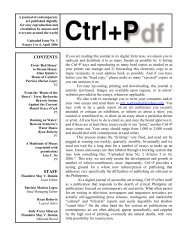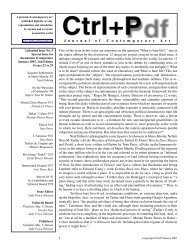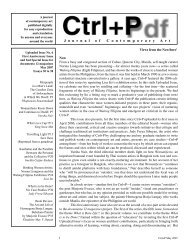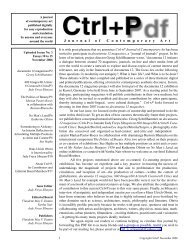Issue 15 - Pdf Ctrl+P - CTRL+P: a journal of contemporary art
Issue 15 - Pdf Ctrl+P - CTRL+P: a journal of contemporary art
Issue 15 - Pdf Ctrl+P - CTRL+P: a journal of contemporary art
Create successful ePaper yourself
Turn your PDF publications into a flip-book with our unique Google optimized e-Paper software.
Endnotes<br />
1. Albano, Raymundo. 1981. “Developmental<br />
Art in the Philippines.” Philippine<br />
Art Supplement. Vol 2 Number 4, p. <strong>15</strong>.<br />
2. Luz, Arturo. “Filipino Painting.” n. d.<br />
3. Albano 1981, p. <strong>15</strong>.<br />
4. Albano 1981, p. <strong>15</strong>.<br />
5. Albano 1981, p. <strong>15</strong>.<br />
6. An account points to other donations<br />
like a mural from Fernando Zobel<br />
and a curtain from Federico Aguilar<br />
Alcuaz, both <strong>of</strong> which seem not to exist;<br />
mentioned as well are the collections <strong>of</strong><br />
Antonio Bantug and Arsenio Escudero.<br />
See De la Torre, Visitacion. 1984.<br />
Cultural Center <strong>of</strong> the Philippines:<br />
Crystal Years. Manila: Cultural Center <strong>of</strong><br />
the Philippines, p. 19.<br />
7. Locsin, Leandro. 1969. “Physical<br />
Aspects <strong>of</strong> the Center.” Inaugural<br />
Program. Manila: Cultural Center <strong>of</strong> the<br />
Philippines.<br />
8. Reyes, Cid. 1989. Conversations on<br />
Philippine Art. Manila: Cultural Center <strong>of</strong><br />
the Philippines, p. 126.<br />
9. De la Torre 1984, pp. 132-133.<br />
10. Ocampo, Galo. 1963. A Brief History<br />
<strong>of</strong> the Development <strong>of</strong> Modern Art in the<br />
Philippines: From 1928 to 1962. Manila:<br />
National Museum, p. 32.<br />
11. Reyes 1989, p. 126.<br />
12. Interview with Purissima Benitez-<br />
Johannot, curatorial staff at MOPA,<br />
December 2008.<br />
13. For thorough discussion <strong>of</strong> the MET,<br />
see Paulino, Roberto. 2005. “The Metropolitan<br />
Museum <strong>of</strong> Manila.” Pananaw 5.<br />
Manila: National Commission for Culture<br />
and the Arts, pp. 30-47.<br />
14. Paulino 2005, p. 37.<br />
<strong>15</strong>. Pastor Roces, Marian. 1986. Piglas:<br />
Art at the Crossroads. Manila: Cultural<br />
Center <strong>of</strong> the Philippines, p. 5.<br />
16. Rivera, A. F. Alfon. 1981. “Art at the<br />
Third Level.” Philippine Art Supplement.<br />
Vol 2 Number 1, p.16.<br />
17. 1988 Thirteen Artists Brochure.<br />
Manila: Cultural Center <strong>of</strong> the<br />
Philippines, n. p.<br />
18. 1988 Thirteen Artists Brochure, n.p.<br />
19.Tence Ruiz, Jose. 2000. “Atras/Avant:<br />
Lessons from a Continuing Reinvention<br />
<strong>of</strong> the Thirteen Artists.” Pananaw 4.<br />
Manila: National Commission for Culture<br />
and the Arts, p. 56.<br />
Second, Marian Pastor Roces advances the astute insight that the CCP visual <strong>art</strong><br />
collection may be viewed as spinning <strong>of</strong>f discretely from the <strong>art</strong> and exhibitions <strong>of</strong> the<br />
seventies at the Center. 43 This stems from the fact that the experiments then were basically<br />
anti-object, keen on dematerialization, basking in ephemera. And so, it may be<br />
argued that this acumen was an immanent critique <strong>of</strong> the necessity <strong>of</strong> a collection at that<br />
time and the way in which the collection festers in the current climate when first-world<br />
amenities are unavailable to arrest the entropy <strong>of</strong> things and to contain the attrition <strong>of</strong> the<br />
collection, tasks that are well-nigh impossible in an unindustrialized economy presided<br />
over mostly by rent-seeking elites. Roces, who conjures the image <strong>of</strong> the collection as<br />
tumor, speculates that this may have been an uncosmopolitan manner <strong>of</strong> sustaining the<br />
cosmopolitan ethos <strong>of</strong> collecting. And she has a very interesting case to make because <strong>of</strong><br />
two things: one is an antecedent modality <strong>of</strong> collecting through the endeavors <strong>of</strong> Luz in<br />
his gallery, which sold antiques ap<strong>art</strong> from marketing fine <strong>art</strong> in the same space, as well<br />
as in MOPA, and second, the Filipiniana collection at the Center. This “ethnographic”<br />
strain in Luz, who extensively traveled and whose abstraction was inspired by temple<br />
and cloth in Asia, would nuance the De Santos and Badillo collection at the Center, supposedly<br />
curated as objets d’<strong>art</strong> by Locsin, whose family in 2008 loaned to Ayala Museum<br />
its exceptional reserve <strong>of</strong> gold and donated to the National Museum Felix Resurreccion<br />
Hidalgo’s The Assassination <strong>of</strong> Governor Bustamante and His Son in 2006. In Fernando<br />
Zobel’s book Philippine Religious Imagery, he states that Luz “owns the finest existing<br />
collection <strong>of</strong> statuettes in the popular style” and that Locsin and his wife Cecilia <strong>of</strong> the<br />
wealthy Yulo clan “have a small but very select collection consisting <strong>of</strong> carefully chosen<br />
examples <strong>of</strong> every style.” 44 The Locsins, who have held the country’s most important<br />
private collection, were also interested in archaeology, having written the important book<br />
Oriental Ceramics Discovered in the Philippines (1967), a culmination <strong>of</strong> their excavations<br />
in Sta. Ana in Manila. This confirms that the Locsin-Ayala-Luz—and, <strong>of</strong> course,<br />
Marcos—loop perseveres.<br />
But this anti-object mentality in the conceptualist model may have in the same<br />
unnerving vein taken a different twist in the Marcos matrix, with things aleatory and<br />
embryonic mutating into things spiritual, the inverse <strong>of</strong> the material or the materialist; the<br />
scientific; or the rational. Emblematic is Jaime Zobel de Ayala’s statement: “The Center<br />
is deeply relevant to our times because a recourse to the spirit and things spiritual is very<br />
much warranted in a time <strong>of</strong> material crisis.” 45 And surely, this appeal to the ineffable may<br />
have been Imelda’s access to <strong>art</strong>, the best way for her to kindle kinship with <strong>art</strong>ists. As<br />
gifted essayist and speechwriter Kerima Polotan Tuvera puts it: “Though she had never<br />
written or painted, and what singing she had done had been on small stages, she understood<br />
the <strong>art</strong>istic alchemy, and if she did not burn deeply with the fever that raged in all <strong>art</strong>ists,<br />
she nursed a touch <strong>of</strong> that sweet delirium, and many saw in her a kindred soul.” Thus,<br />
Imelda, whose penchant for adornment and decoration – indeed, beautification -- imbued<br />
her festivalist imaginary, was, therefore, attracted to <strong>art</strong>, a fascination that required no<br />
exegesis. This rambling rumination is fabulist: “I like the modern. I like the abstract. I<br />
like them because they get me thinking. You know, sometimes I do not understand them.<br />
I like things I do not understand because they make me curious. I do not claim to be a<br />
technician or a scientist in the <strong>art</strong>s. But, as I always say, when I like something, I like it<br />
even though I have no reason for it. Just like friends. There are friends you like but you<br />
don’t know the reason.There are paintings you like but you don’t know the reason.” 46<br />
It is this reverie that coddled the dreams <strong>of</strong> Imelda <strong>of</strong> the Platonic ideals <strong>of</strong> the true, the<br />
good, and the beautiful. When Imelda, a woman <strong>of</strong> appreciable beauty and charisma,<br />
spoke <strong>of</strong> these virtues, it looked and sounded exceedingly credible.<br />
Finally, and this is the other path through which the “collecting” at the Center may<br />
have been paved: the conceptualist posture to question the basis <strong>of</strong> <strong>art</strong>ness, or its objecthood<br />
within the spectrum <strong>of</strong> institutional critique, only that in this setting the institution<br />
itself <strong>of</strong> authoritarian rule was spared. Still, the instinct to appropriate material culture<br />
<strong>of</strong> everyday life and behold it on the plinths <strong>of</strong> the museum at the Center furthered the<br />
conceptualist mindset to restore the integrity <strong>of</strong> the object before it is devoured by the<br />
modernism <strong>of</strong> <strong>art</strong> or the mercantilism <strong>of</strong> the market, to dematerialize it conceptually in<br />
a paradoxically sensory and intersubjective, even immersive, atmosphere.<br />
44 <strong>Ctrl+P</strong> September 2009







